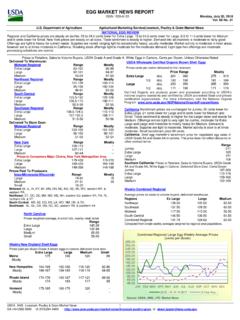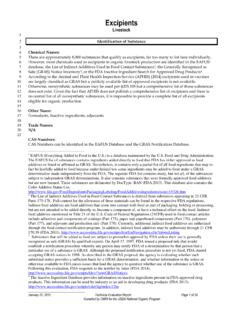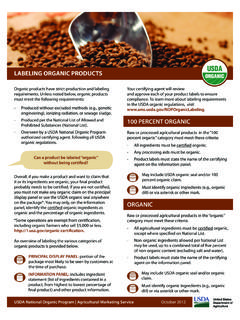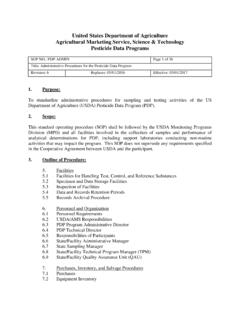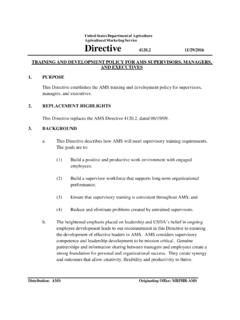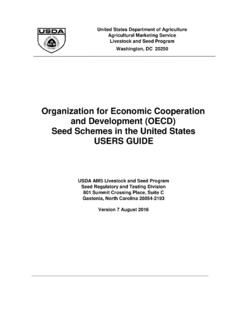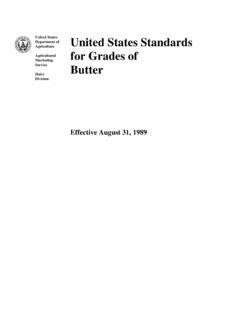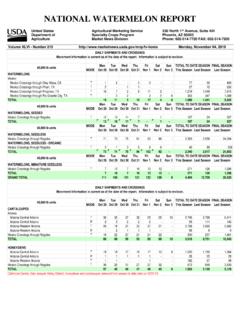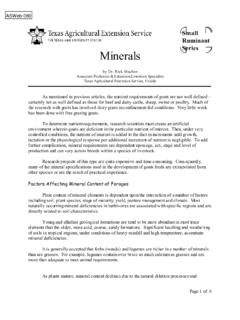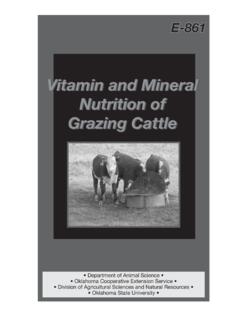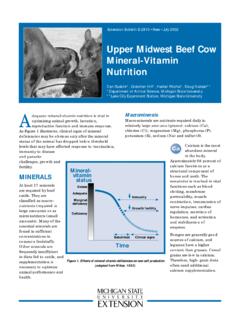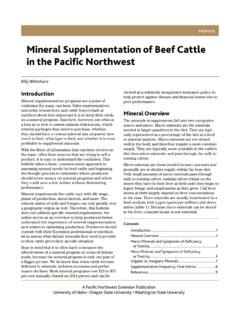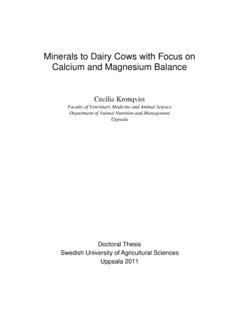Transcription of PROTEINATED AND CHELATED MINERAL COMPLEXES …
1 CFNP TAP Review PROTEINATED and CHELATED MINERAL COMPLEXES 8/12/2002 PROTEINATED AND CHELATED MINERAL COMPLEXES livestock executive summary Chelation refers to a bonding formed between a metal ion ( MINERAL ) and a ligand (protein or amino acid chelating agent) carrier. A MINERAL complex is a mixture consisting of a MINERAL and an organic compound carrier, such as a protein or polysaccharide; a chelate is a type of complex. The petition under review requests that MINERAL chelates and COMPLEXES be added to the National List as allowable feed additives in organic livestock production, to serve as dietary nutritional supplements of trace minerals. One of the issues central to the petition is the request that synthetic amino acids be allowed as possible chelating agents.
2 The other two chelating agents listed, proteins and polysaccharides, do not utilize synthetic amino acids. Currently, there is no NOSB recommendation on synthetic amino acids, although the issue has been examined previously. summary of TAP Reviewer s Analyses1 Synthetic/ Nonsynthetic Allow without restrictions? Allow only with restrictions? (See Reviewers comments for restrictions) Synthetic/Nonsynthetic (3) No (3) Yes (2) No (1) Identification Names and numbers: Commonly CHELATED /complexed minerals: CAS # Name Abbr. Atomic # Atomic Weight 7440-70-2 Calcium Ca 20 7440-48-4 Cobalt Co 27 7440-50-8 Copper Cu 29 7439-89-6 Iron Fe 26 7439-95-4 Magnesium Mg 12
3 7439-96-5 Manganese Mn 25 7440-09-7 Potassium K 19 7440-66-6 Zinc Zn 30 1 This Technical Advisory Panel (TAP) review is based on the information available as of the date of this review. This review addresses the requirements of the Organic Foods Production Act to the best of the investigator s ability, and has been reviewed by experts on the TAP.
4 The substance is evaluated against the criteria found in section 2119(M) of the OFPA [7 USC 6517(m)]. The information and advice presented to the NOSB is based on the technical evaluation against that criteria, and does not incorporate commercial availability, socio-economic impact, or other factors that the NOSB and the USDA may want to consider in making decisions. CFNP TAP Review PROTEINATED and CHELATED MINERAL COMPLEXES 8/12/2002 2 Common amino acid chelating agents: 2,3 CAS # Name Abbr. Formula Linear Structure 56-87-1 Lysine Lys C6-H14-N2-O2 H2N-(CH2)4-CH(NH2)-COOH 72-19-5, 80-68-2 Threonine Thr C4-H9-N-O3 CH3-CH(OH)-CH(NH2)-COOH 54-12-6, 73-22-3 Tryptophan Trp C11-H12-N2-O2 Ph-NH-CH=C-CH2-CH(NH2)-COOH Categories of chelates and other COMPLEXES : Metal (Specific Amino Acid) COMPLEXES : IFN Copper lysine complex IFN Zinc lysine complex IFN 6-16-294 Ferric methionine complex IFN 6-19-212 Manganese methionine complex IFN 6-16-293 Zinc methionine complex Metal Amino Acid COMPLEXES .
5 IFN 6-32-053 Copper amino acid complex IFN 6-32-054 Zinc amino acid complex IFN 6-32-055 Magnesium amino acid complex IFN 6-32-056 Iron amino acid complex IFN 6-32-058 Calcium amino acid complex IFN 6-32-059 Potassium amino acid complex IFN 6-32-060 Manganese amino acid complex Metal Amino Acid Chelates: IFN 6-20-981 Calcium amino acid chelate IFN 6-20-982 Cobalt amino acid chelate IFN 6-20-983 Copper amino acid chelate IFN 6-20-984 Iron amino acid chelate IFN 6-20-985 Magnesium amino acid chelate IFN 6-20-986 Manganese amino acid chelate IFN 6-20-987 Zinc amino acid chelate Metal Proteinates: IFN 6-09-896 Copper proteinate IFN 6-09-897 Zinc proteinate IFN 6-26-149 Magnesium proteinate IFN 6-26-150 Iron proteinate IFN 6-26-151 Cobalt proteinate IFN 6-26-834 Manganese proteinate IFN 6-16-833 Calcium proteinate Metal Polysaccharide COMPLEXES : IFN 8-09-822 Copper polysaccharide complex IFN 8-09-898 Iron polysaccharide complex IFN 8-09-899 Zinc polysaccharide complex IFN 8-19-206 Magnesium polysaccharide complex Characterization Composition/Properties: Definitions of various types of metal chelates/ COMPLEXES , as provided by the American Association of Feed Control Officials (AAFCO), are as follows.
6 Metal (Specific Amino Acid) Complex is the product resulting from complexing a soluble metal salt with a specific amino acid. Minimum metal content must be declared. When used as a commercial feed ingredient, it must be declared as a specific metal, specific amino complex: , copper lysine; zinc lysine; ferric methionine; manganese methionine; and zinc methionine. (Proposed 1991, Adopted 1992.) Metal Amino Acid Complex is the product resulting from complexing a soluble metal salt with an amino acid(s). Minimum metal content must be declared. When used as a commercial feed ingredient, it must be declared as a specific metal amino complex: , potassium amino acid complex; copper amino acid complex; zinc amino 2 Amino Acids.
7 Institute of Chemistry, FU Berlin. 3 ChemID Plus. CFNP TAP Review PROTEINATED and CHELATED MINERAL COMPLEXES 8/12/2002 3 acid complex; zinc amino acid complex; iron amino acid complex; cobalt amino acid complex; cobalt amino acid complex; calcium amino acid complex; and manganese amino acid complex. (Adopted 1990.) Metal Amino Acid Chelate is the product resulting from the reaction of a metal ion from a soluble metal salt with amino acids with a mole ratio of one mole of metal to one to three (preferably two) moles of amino acid to form coordinate covalent bonds. The average weight of the hydrolyzed amino acids must be approximately 150 and the resulting molecular weight must not exceed 800.
8 The minimum metal content must be declared. When used as a commercial feed ingredient it must be declared as a specific metal amino acid chelate: , calcium amino acid chelate; iron amino acid chelate; magnesium amino acid chelate; manganese amino acid chelate; or zinc amino acid chelate. (Proposed 1986, Adopted 1988.) Metal Proteinate is the product resulting from the chelation of a soluble salt with amino acids and/or partially hydrolyzed protein. It must be declared as a ingredient as the specific metal proteinate: , copper proteinate; zinc proteinate; magnesium proteinate; iron proteinate; cobalt proteinate; manganese proteinate; or calcium proteinate. (Proposed 1967, Adopted 1970, Amended 1977, Amended 1987.) Metal Polysaccharide Complex is the product resulting from complexing of a soluble salt with a polysaccharide solution declared as an ingredient as the specific metal complex: , copper polysaccharide complex; zinc polysaccharide complex; iron polysaccharide complex; cobalt polysaccharide complex; and manganese polysaccharide complex.
9 (Proposed 1971, Adopted 1973.)4 How Made: Chelation, which literally means bringing together, refers to a bonding formed between a metal ion ( MINERAL ) and a ligand (protein or amino acid chelating agent) carrier. A MINERAL complex is a mixture consisting of a MINERAL and an organic compound carrier, such as a protein or polysaccharide; a chelate is a type of complex. Chelates are generated by reacting a MINERAL salt with, for example, an enzymatically prepared mixture of amino acids and small peptides, under controlled conditions. The ligand binds the metal at more than one point such that the metal atom becomes part of a ring. Certain amino acids and protein digestion products such as small peptides are ideal ligands because they have at least two functional groups (amino and hydroxyl) that can form a ring structure with the MINERAL .
10 The resulting MINERAL -organic complex is a chelate. The primary CHELATED minerals used in animal feed are the trace elements iron, manganese, cobalt, copper, and zinc. These Transitional Elements on the Periodic Table have chemical characteristics intermediate between metal and non-metal elements. Transitional elements prefer to form coordinate covalent bonds, a hybrid form of linkage that gives them their unique ability to form stable COMPLEXES --coordination COMPLEXES or chelates. 5,6,7 Calcium, magnesium, and potassium are also administered in complexed form. Perhaps one of the key issues in this petition is whether or not synthetic amino acids, possible chelating agents in complexed minerals, should be allowed. One of the oldest and most widely used applications of biotechnology in the animal feed industry is that of synthetic amino acids.
